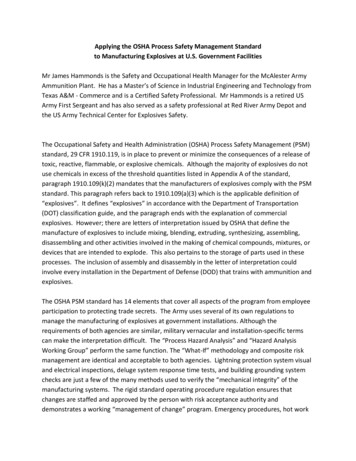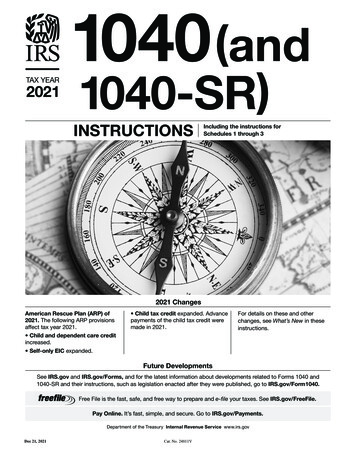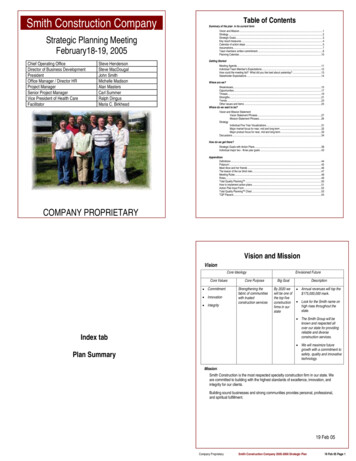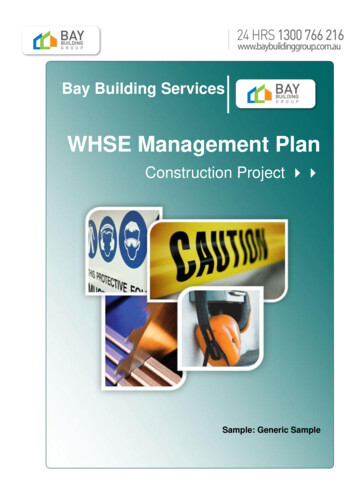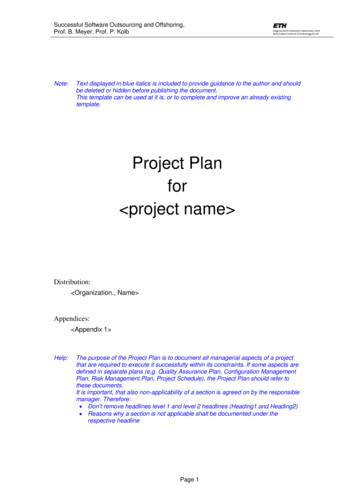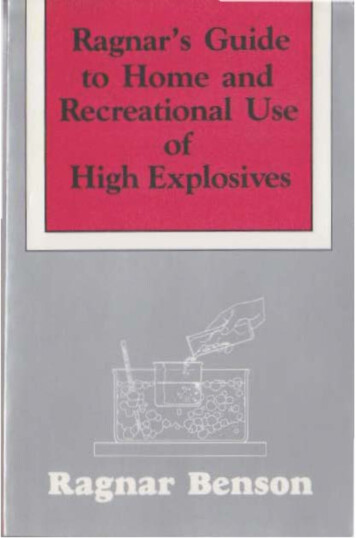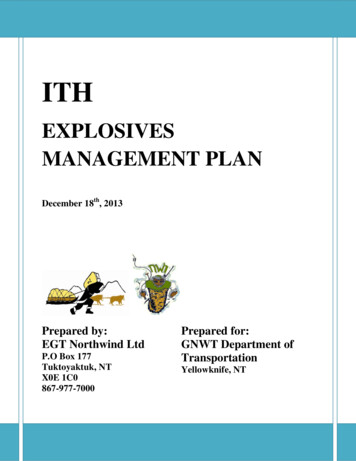
Transcription
ITHEXPLOSIVESMANAGEMENT PLANDecember 18th, 2013Prepared by:EGT Northwind LtdP.O Box 177Tuktoyaktuk, NTX0E 1C0867-977-7000Prepared for:GNWT Department ofTransportationYellowknife, NT
Table of ContentsPage1Introduction32Explosive Management Plan Objectives33Ammonia Nitrate3.1 Nitrate Loss Mechanisms3.2 Mitigation Strategy3344Explosive Usage4.1 Explosive Material Ratios445Transport of Explosives66Explosive Storage6.1 Explosive Magazines (Off-Site Storage)6.2 Explosive Magazines (On-Site Storage)7787Best Management Practices7.1 Personnel Training Program888Blasting Operations8.1 Blasting Safety Measures8.2 Spill Prevention8.3 Disposal of Explosives8.4 DFO Commitments991011129Internal Audit and Inspections12List of TablesTable 4.0-1Table 4.0-2Table 4.0-3Explosives – Hazard Class and Potential ImpactsExplosives – Safe Handling ProceduresExplosives – Personal Protective Equipment556MapsAppendix 1Construction Plan Overview Atlas213 - 18
1.0INTRODUCTIONThe Inuvik to Tuktoyaktuk Highway Project (ITH) is a 137 km highway which will requireapproximately 5.8 million in-place cubic metres of gravel (not including the Source 177Upgrade) for embankment construction with 250,000 cubic metres of surfacing gravel. In orderto quarry this material, explosives will be employed as a primary means of breaking the frozenmaterial from designated sources. These designated sources are attached on Appendix A –Construction Plan Overview Atlas2.0EXPLOSIVES MANAGEMENT PLAN OBJECTIVESThe purpose of the Explosive Management Plan is to outline management practices employed onthe ITH Project that are aimed to minimize the safety and environmental risks of handlingammonia nitrates, which are present in blasting agents. Specifically, methods used to minimizeammonia nitrate losses to the environment will be explained.2.1Legislation ComplianceThe Blasting Contractor will operate and will be compliant under the following legislation: NWT Mines Act and Regulations WSCC Occupational Health and Safety Regulations ERD Federal and Territorial/Provincial Legislations and Guidelines2.2Environmental Management PlanThe Explosives Management Plan is a component of the ITH Project’s EnvironmentalManagement Plan. Several of the plans within the Environmental Management Plan relate tospill management and water quality monitoring, and complement the best practices identified inthe Explosives Management Plan: Spill Contingency Management Plan Fish and Fish Habitat Protection Plan3.0AMMONIA NITRATE MANAGEMENT3.1Nitrate Loss MechanismsBlasting is subject to regulations limiting ammonia, nitrate, and nitrate levels in quarry effluentsreleased into the environment. The primary source of these nitrogen compounds is typicallyexplosive used in blasting operations, as AN remains a significant component of most explosivesused in the blasting industry. The amount of AN entering a local water drainage system is relatedto site conditions, explosives used, explosive handling, and blast efficiency.The key mechanism by which AN is lost to the water drainage system are as follows:3
Spillage during blasthole loading or transportation to the blast site;Dissolution by standing or flowing water through the blasthole;Erosion of explosive from high flowing water through the blasthole; and,Leaching of undetonated explosive from the blasted muck.3.2Mitigation StrategyIn order to minimize potential impacts, an explosives management plan will be implemented aspart of the construction start-up. In addition to what is included in this management plan, theexplosives management strategy will include the following: 4.0An education program for all production employees that outlines the potential problemand appropriate mitigation techniques;A Spill Contingency Management Plan;A monitoring program that is integrated with baseline water quality information (Fish andFish Habitat Protection Plan);A review of blasting operations early in production to determine efficiency levels.EXPLOSIVE USAGEExplosives use management will have the primary goal of limiting loss of ammonia nitrates toquarried material, pit areas, and water bodies, which could subsequently leach into runoff.Explosives storage will be controlled and runoff from storage areas contained although it isexpected that all blasting activities will be completed during winter months prior to any freshetrunoff.The project proposes to use packaged ANFO (ammonium nitrate/fuel oil) to facilitate borrowsource extractions. ANFO is a solid material that is a widely used bulk industrial explosivemixture. It consists of 94 percent ammonium nitrate (NH4NO3), (AN) that acts as the oxidizingagent and absorbent for the fuel and six percent number 2 fuel oil (FO).The detonation of ANFO will produce gaseous byproducts. Complete detonation of ANFOproduces H2O, CO2 and N2, which are harmless gases. Incomplete detonation of ANFOproduces NO2, NO and CO which is toxic gases in high concentrations. Incomplete detonationcan occur when blast holes contain water or if ANFO becomes wet. Since ANFO is hydroscopicand water soluble, the appropriate overall methodology for management is keeping it sealed anddry, which is consistent with blasting mid-winter and the overall low humidity in the region.Blast holes are not expected to contain any water during winter. Any spills are managed with thecleanup of the solid ANFO (as per the Spill Contingency Management Plan). Explosives will be4
managed in accordance with the Guidelines for the Use of Explosives in or Near CanadianFisheries Waters (DFO 1998). With the application of these practices, there is not expected to bea pathway for residue and/or gases to enter adjacent water bodies.4.1Explosive Material Ratios Hole size: 6 1/2"Average hole depth: 8 mPattern: 4 meters x 5 mPowder Factor: .7 - 1 kg per m3 Products Utililized:Amex; 25 kg, double-lined bags200 x 400 mm Power Pro; 20 kg boxesXT Det Cord; 15 kg casesNonels; 9 m - 15 m lengthsMaterial hazard class, potential impacts, site handling and storage requirements, andrecommended personal protective equipment are summarized in Tables 3.0-1 to 3.0-3.Table 4.0-1 Explosives – Hazard Class and Potential ImpactsMaterialHazard ClassAmmonium Nitrate5.1High Explosive DetonatorsBlasting Caps11Table 4.0-2 Explosives – Safe Handling ProceduresMaterialAmmonium Nitrate5Potential ImpactWater & SoilContaminationNegligibleNegligibleSafe Handling ProceduresKeep away from heat and sources ofignition. Do not ingest or breathe dust. Incase of insufficient ventilation, wearsuitable respiratory equipment. Avoidcontact with skin and eyes. Store in a cool,well-ventilated area separate from acids,alkalies, reducing agents and combustibles.
High Explosive DetonatorsStore under dry conditions in a cool, wellventilated magazine in closed containers.Keep away from heat, sparks, and flames.Store under dry conditions in a cool, wellventilated magazineBlasting CapsTable 4.0-3 Explosives – Personal Protective EquipmentMaterialPersonal Protective EquipmentEyesSkinRespirationAmmonium NitrateSafety gogglesNitrile or rubberNIOSH/MSHAgloves; protectiveapproved respiratorclothingHigh Explosive DetonatorsSafety gogglesNitrile or rubberNone usuallygloves; protectiverequiredclothing made fromcottonBlasting CapsSafety gogglesNitrile or rubberNone usuallygloves; protectiverequiredclothing made fromcotton5.0TRANSPORT OF EXPLOSIVESThe handling of explosives to the site and on the site will be carried out by the supplier andblasting contractor under a license to conduct such work.Transportation of explosives from the explosive supplier to the quarry areas will be conducted insuch a manner as to safeguard human health and prevent impacts on the environment. Thetransfer will be arranged so that: delays between the points of transfer are minimizedexplosives are not left at any location other than designated locationsexplosives are not left unattended during transportationTransportation of explosives will be undertaken according to the requirements of applicableregulations including the Canada - Explosives Act and Regulations; Transport of Dangerous6
Goods Act and Regulations; National Fire Code of Canada. The explosives contractor andpersonnel are responsible for ensuring compliance to these regulations.Explosives transported from the explosives supplier to the site will be transported by fullylicensed and certified transport carriers; always utilizing a double-driver system. These carrierswill be fully compliant with applicable Federal, Provincial and Territorial legislation regardingexplosives hauling and transport and applicable TDG guidelines and compliance. Theseoperators or transport drivers will be fully versed in their 'specific' companies' EmergencyResponse Procedures for TDG and explosives transport.Associated risks or possible emergency situations associated with transport could include: Motor vehicle accident (MVA) requiring simple transfer of explosives to alternatevehicledesigned for transporting explosives MVA with our without injuries, where explosives have been spilled on roadbed Motor vehicle breakdown (mechanical); delay in transport MVA with fire and potential for detonation, and finally in a worst case scenario, MVA with a detonationMobile equipment used for transporting explosives onsite will: be kept in sound mechanical working conditionbe provided with orange diamond-shaped placards and with clearly visible signs marked"EXPLOSIVES" in letters not less than 150 mm in height when carrying explosivesnot be used to transport other goods or materials at the same time as explosives aretransportedbe equipped with a type 20-ABC fire extinguishernot be loaded with explosives in excess of 80% of its rated carrying capacityhave explosives secured or fastened so as to prevent any part of the load from becomingdislodgedonly be operated by an authorized person who is in attendance at all timescarry only those persons necessary for handling explosivesnot be refueled if explosives or detonators are on board except where the mobileequipment is designed and used solely for transportation of bulk blasting agentshave its engine shut off and its parking brake engaged while loading or unloadingexplosives, except where the vehicle uses an engine-powered device for loading andunloading6.0 EXPLOSIVES STORAGE7
Packaged ANFO, detonators, and primers, will be shipped to site as explosives and be stored insite magazines.6.1 Explosive Magazines (Off-Site Storage)Explosives magazines to be fully licenced, equipped with security reader system and properlocking system as per ERD Federal and Provincial/Territorial regulations Explosives (Powder) magazine registered to contain 30,000 kgs of product Detonator (Cap) magazine registered to contain 20,000 units As security precaution and to monitor magazine access and as per ERD Federalregulations, electronic monitoring of magazines will be completed by the Blaster(s) uponeach entry into magazines utilizing the electronic fob reader provided Signage will be clearly posted at magazines, as required, warning of potential danger,safe distances and hazards in storage vicinity Blaster(s) to monitor magazine(s) inventory by continually updating productsadded/taken in the blasthole logbooks, provided in each magazine Magazine inspections to be completed by Blaster(s) on a weekly basis6.2Explosive Magazines (On-Site Storage)Explosives (Amex), will be situated near the worksite, when required. Each pallet will contain 50bags of Amex, which, will be shrink-wrapped. Explosives stored on-site would be placed indesignated work area under constant (24 hour) watch/supervision. Explosives will never be leftunattended, at any time. Explosives (Powder) stored in powder trucks: 1,500 to 2,000 bags per truck Explosives (Detonators) stored in powder trucks: 300 to 400 units (or 6 to 8 boxes) pertruckLocations of the magazines will be site specific and will follow the guidelines below: 7.0a minimum of 500 metres away from camps or any structures that frequently housepersonnela minimum of 500 metres away from quarrying activitiesset on flat terrain to reduce the risk of spillagearea around magazines to be flagged with required signageBEST MANAGEMENT PRACTICESOnly trained and certified persons will work with explosives. The explosives personnel willundertake formal training and on-the-job training to ensure compliance with legislation. Internalaudits and inspections of all components related to the explosives management will be conducted8
on a regular basis by qualified personnel, and the results recorded according to quality and safetystandard operating procedures. All recommendations and orders made by regulators andinspectors will be responded to and acted upon accordingly.7.1Personnel Training ProgramOnly trained and certified persons will work with explosives. The explosives personnel willundertake formal training and on-the-job training to ensure compliance with legislation. Trainingrequirements will include (but not be limited to): Specific fire procedures as per the Federal Explosives Act; First Aid; Transportation of Dangerous Goods (TDG); Blasting Certificate; and Workplace Hazardous Materials Information System (WHMIS).8.0BLASTING OPERATIONSBlasting will be carried out by a certified blasting contractor following blasting regulations andsafety protocols and under the supervision of General Contractor. A revised detailed ExplosivesManagement Plan will be developed by the blasting contractor and reviewed by the GeneralContractor.Blasting operations on the ITH Project will involve a qualified and licensed explosivescontractor responsible for all blasting operations. The explosives contractor will be responsiblefor the inspection of all explosives facilities and the safe operation of all explosives equipment.Weekly reports to the General Contractor detailing total explosives consumption, inventory ofammonium nitrate onsite, other explosiv
Explosives (Powder) magazine registered to contain 30,000 kgs of product Detonator (Cap) magazine registered to contain 20,000 units As security precaution and to monitor magazine access and as per ERD Federal regulations, electronic monitoring of magazines will be completed by the Blaster(s) upon
